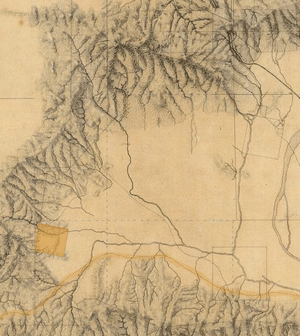Rancho El Escorpión facts for kids
Rancho El Escorpión was a large piece of land, about 1,110 acres (4.5 km²), located in what is now Los Angeles County, California. In 1845, the Mexican Governor Pío Pico gave this land as a "land grant" to three Chumash Native Americans: Odón Chijulla, Urbano, and Mañuel.
This ranch was shaped like a half-square and was located at the western end of the San Fernando Valley. It was near Bell Creek and the Simi Hills. Today, parts of this land are in areas like West Hills and Woodland Hills.
Contents
What Does "El Escorpión" Mean?
The name "Rancho El Escorpión" comes from the Spanish word for "scorpion." This area was once home to a Fernandeño (Native American) village. The village's name in their language, a dialect of the Tongva language, was Atɨ́'vsɨng, which also meant "scorpions." So, the ranch was named after this ancient village and its meaning.
Who Owned Rancho El Escorpión?
The first owners of Rancho El Escorpión were three Chumash people:
- Odón Eusebia (born around 1795)
- His son-in-law, Urbano (born around 1799)
- Urbano’s son, Mañuel (born around 1822)
This land used to be part of the San Fernando Mission. Urbano Chari was one of the few Native Americans in 1850 who owned valuable land. He owned Rancho El Escorpión with Odón and Mañuel until he passed away around 1860.
Changes in Ownership After the War
After the Mexican-American War, California became part of the United States. The 1848 Treaty of Guadalupe Hidalgo promised that existing land grants would still be valid. So, in 1852, a claim for Rancho El Escorpión was officially filed with the U.S. government. The land was officially given to Odón, Urbano, and Mañuel in 1876.
Miguel Leonis and the Ranch
Miguel Leonis (1824–1889) came to Los Angeles in 1854 from France. He first worked as a shepherd for Joaquín Romero, who owned land next to Rancho El Escorpión. Later, Romero sold his property to Leonis.
In 1871, Miguel Leonis bought Odón Chijulla's share of Rancho El Escorpión. He also acquired an adobe house on nearby land in Calabasas. Leonis used the ranch for raising cattle and sheep. He became very powerful in the area, known as the "King of Calabasas."
The Legal Battle for the Ranch
When Miguel Leonis passed away in 1889, he left most of his property to his family in France. He stated that Espíritu Chijulla, Odón's daughter, was only his housekeeper, not his wife. He left her a small amount of money, even though his estate was very valuable.
Espíritu believed she was his wife and fought for her rights in court. Her lawyer was Major Horace Bell, who was also her neighbor. The case was very complex and went to the California Supreme Court three times over 16 years.
In 1905, the court finally decided that Espíritu and Leonis were legally married. This made Espíritu the first common-law spouse in California to win such legal rights. She inherited Rancho El Escorpión. However, she passed away a few months later in 1906.
The Ranch is Sold
Espíritu's son, Juan José Menéndez (also known as Melendrez), and his wife, Juana Valenzula de Menéndez, inherited the ranch. In 1912, they sold Rancho El Escorpión, which was still 1,110 acres, to George Platt.
George Platt started a dairy farm on the land, calling it Platt Ranch, or sometimes Ferndale, 'escorpion', or Cloverdale Dairy. The land remained open and undeveloped until 1960. It wasn't officially part of the city of Los Angeles until 1958.
Images for kids



